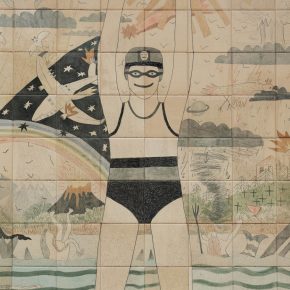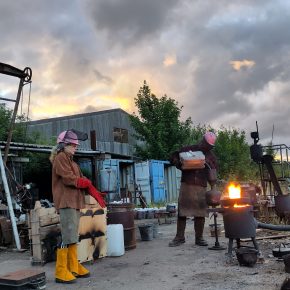STUDIO CONVERSATION WITH YOTAM SIVAN
Is this the first time that you are firing something, you haven’t worked with ceramics before?
I have worked with clay, but mostly to make a form and then mold it and replicate it. On my MFA, it was somewhere between impossible and very difficult to fire anything, because they didn’t even have a kiln on site, and they outsourced it to a different place, with a big queue – it was too logistically complicated.
You have recently had a Workshop Induction here, did it give you some confidence to get going?
Well, I don’t need confidence because, you know, if I make a mistake, I make a mistake, right? This piece for example, I really didn’t know if this was going to survive the firing, because there are all these pieces attached. Some of them did break. In a good way. A good way because I purposely reinforced these joints with glaze. It’s a learning experience, and of course I’d be sad if it wouldn’t come out right, but regardless of failure or success, it’s just as exciting.
Are you in the middle of a project or starting a new one?
I am starting a new process because I’ve only gotten into a studio two months ago. The purpose here is to start working and accumulating objects and understanding the connections between them to see what form of structure it takes. That’s how I work. I don’t like to think of an end result. I don’t like to be worried about what it’s going to end up looking like, because every time I force my intention on material it just doesn’t work out. Every time I have too concrete a project it doesn’t feel as alive. Each of these objects I am making has a specific thing that interests me. For example, with this one, I was thinking of words, forms and metaphors. Forms that are not trying to be anything specific, they’re not trying to follow an aesthetic, they’re not trying to say anything. They don’t have a concrete story. It’s a lack of intention. I’m interested in how meaning forms organically through symbols and through appropriation.
You find yourself in a particular state of mind for this work?
Oh yeah, definitely, it’s like a game, like when you’re bored as a kid and start making out faces in the clouds. It’s interesting to me to see that kind of tension between an abstract form and the meaning we make for it. You have to be in a state of mind where you just let things take shape organically, and then you start seeing repetition and ideas coming together, and that gives you a better understanding of what you’re doing. The whole thing is a cycle. I have all these objects and I’m not sure, yet, how they all come together. Most of them, or some of them, might not come together, which is also fine. It’s like writing a bunch of unrelated sentences and starting to see, like a conspiracy theorist, all those little connections. It’s an endless process.

How long you are here at ESW?
I’m here for six months. Part of my proposal was about mushrooms, because fungi are fascinating and they can help you look at the larger perspective of the environment. If I am looking for, let’s say, porcini, then I’m looking for a specific type of tree, because porcini exists in symbiosis with pine trees. I have to understand where pine trees are, then the larger environmental aspect. Fly Agarics are also good indication of where you can find porcini.
So, how do mushrooms inform your practice?
There are a lot of processes and ideas there that I’ve already adopted into my practice. Fungi have extraordinary forms, but I don’t want anything of what I do to just be an aesthetic thin, shallow veneer.
I don’t know what the outcome will be, you have the aspect of form, but you’ve also got the invisible network and how fungi interacts with different animals and plants.
You are planning to split your time between the metal, ceramic and wood workshops?
That’s the goal. Today I’m going to have a blacksmithing induction and tomorrow a woodworking induction. That’s why ESW is so great for me because there’s a very wide array of disciplines and materials to work in.
The more skilful you get the more freedom you have.
Exactly, it brings me a lot of pleasure to learn, and I think art should be about pleasure as well. That’s what I enjoy the most, this fluidity between different materials, and the freedom to take spontaneous decisions.
Will you do any casting?
I would like to cast iron if I have the chance. I would even like to make iron – I’d would love to meet people who know what they’re doing and just witnessing the process of smelting iron or refining. It’s taking nature in the form of a rock and turning it into a man-made object. I’m against this idea that there are chemical things and natural things. Nature is full of chemicals. There’s no hard line that separates them, the most artificial thing we can conceive of, let’s say plastic, it is made from animals that died eons ago. It is made from crude oil, which is just a carbon deposit made of countless animal and plants. I try to think of things in a very wide way.
Small scale or large scale?
At this point I want to be as intuitive as possible so I’m starting small. The whole body of work, in a sense, is modular and I am testing ideas of how all these components can become part of a structure. I would usually have a lot of other objects that aren’t made by me, but I’ve not collected enough yet. I need more time.
Do you dream of something for the future?
Oh, I would love to have my own place where I have access to all these amazing tools and machines, be able to just work freely and to make objects. One of the reasons I like being around workshops is that, in terms of making practices, a workspace has a lot of authenticity and so do tools. A tool is being designed only for a very specific job, so it’s not going to resemble any other tool and it matches a hand, a practice and a discipline. If you were making it to be an art object, the intention can often alter it. I feel that intention contaminates. Toolmaking is not about aesthetics; it’s about the functioning of things. There are still aesthetic decisions, and those tend to be really interesting because they don’t have to be there. There’s a sense of creativity and individuality that comes into it almost subconsciously. A tool that was made in the Bauhaus movement, is not going to look the same as a Japanese tool from 200 years ago. They look different because the whole social concept is different, the whole culture is different. The tool becomes a crystallization of a whole culture and ideas of what could be design and art, usability, utility, all these things differ from country to country, from place to place, and from person to person.
So, I look for places where art is made accidentally or coincidentally. I’m doing archaeology in reverse, like imagining a relic from the future, what would future people be able to understand about our culture by looking at an object? I think that they’ll be able to understand quite a lot – our technical capacities, our technological level, they can see that there’s plastic here, so they can figure out that that we couldn’t care less about the environment, or they can see the grind marks and figure out the making process. They would also be able to see that historically a lot of tools have been made for men, so this has to mean something for manhood, and about how our culture perceives manhood.
What are the tools that you are going to make?
Well, from this bit of steel, I would like to try to make a tool for working with wood and one for gathering mushrooms.
Studio conversation with studio holder Yotam Sivan, April 2023
More about Yotam’s projects and work here




